Earlier, I touched upon Cloth of Gold, exploring what it is and how it’s made. This exquisite textile made of gold-wrapped thread is expensive, somewhat hard to come by, and, in antique textiles, highly desired when in good shape. Here, I’m examining a piece made of cloth of gold, but which has unfortunately been damaged. The question is whether or not it is completely beyond repair.
The piece is a liturgical stole made from cloth of gold. It matches an exquisite set of vestments made from the same fabric.
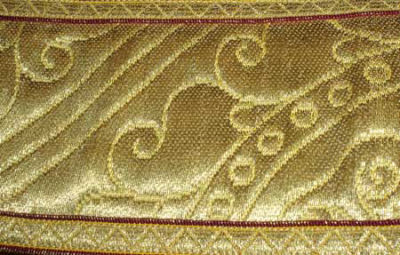
This is a shot of one side of the stole, where the cloth of gold is in excellent shape, especially considering the age and the use of the piece.
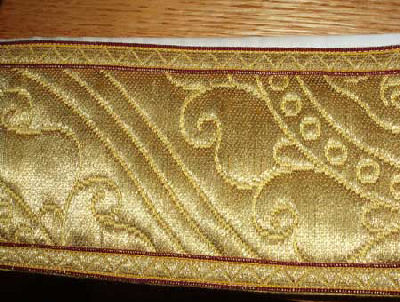
And here is the other side, where you can see that the piece really is exquisite. The nature of this particular cloth is damask-like, with a pattern woven into the overall cloth. It is not embroidered in any way – the pattern you see is simply part of the pattern of the cloth.
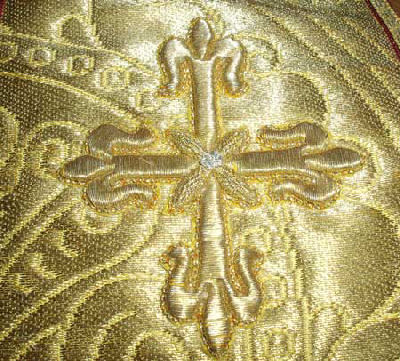
There’s a beautiful goldwork cloth on each side of the front of the stole. Again, it’s in really good shape – there are a few spots where the gold thread is broken, but overall this does not mar the beauty of the piece. Age and wear are not highly evident.
But then, the tragedy:
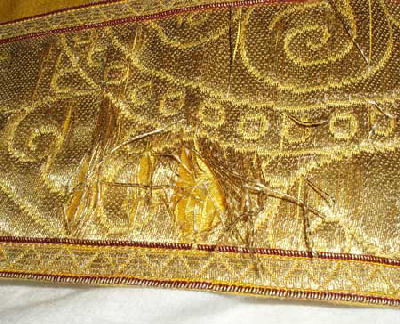
Here you can see the torn fibers that need repair. Note how the cloth of gold is made in layers – underneath the gold thread, there are at least three layers: the first is the “base” of the fabric – it looks like a coursely woven material. The second and third layers directly under the gold are soft gold-colored thread in layers like padding. Then comes the gold.
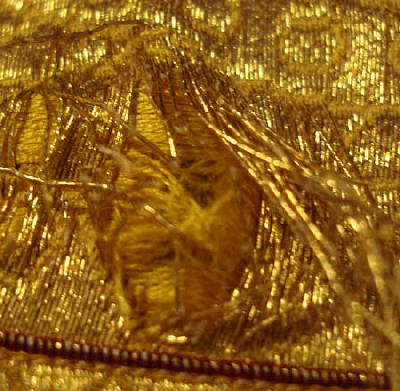
It reminds me somewhat of shredded wheat cereal. What a mess! The question is, how can cloth of gold like this be repaired in a way that shows the least amount of damage? I’m musing over this question – and if you have any ideas, I’m all ears!
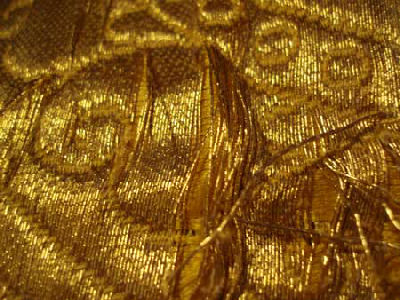
Here’s the spot on the opposite side of the stole – not as bad, but still noticeably damaged!
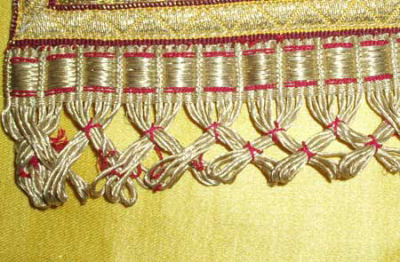
The fringe at the bottom of the stole also needs some attention. The strands are crossed and held together by red thread, in an attractive pattern, but the red thread needs work!
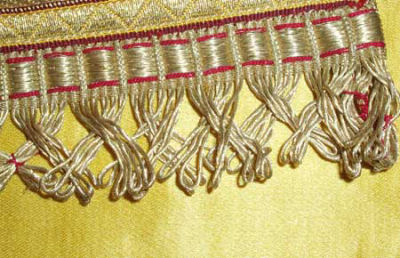
In fact, the red thread is completely missing on half of the fringed edge.
The fringe won’t be difficult to fix up. It’s not really damaged – it just needs to be re-worked with red thread.
The cloth of gold itself, though, definitely needs repair before this piece can be used again. So here’s my question: any good ideas on how to go about this? Of course, there are always those professionals that restore textiles, but I’m going to (very carefully!) give it a go myself before resorting to a professional. This may be a mistake, but the cost of such a repair would probably be tremendous, if it can be done at all.
If you have any thoughts, suggestions, ideas, or inspirations, feel free to share ’em!




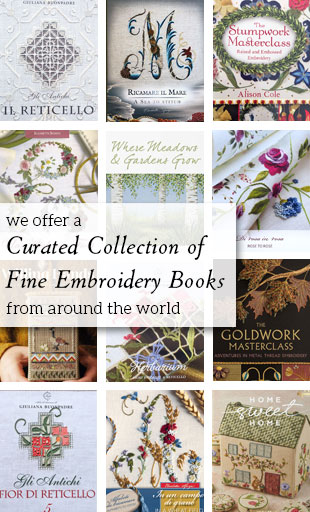


That gold work is very beautiful, it’s almost saddening to see it so damaged. This is a huge undertaking! I wish you the best of luck!
Hello, Mary. My solution is complex, but it comes from my professional experience as an invisible reweaver.
1. Stuff a small wad of lamb wool (purchased through leather repair kits) in the “center” of damage. Carefully cover with tight clean but soft cotton square on side that will NOT be worked on (back).
2.Using silk thread of the same twist and shade, first run stitches that catch tiny bits of the original padding. After the padding has been laid down, now fill in missing padding strokes.
3.Using a light brown wig of real hair, pull a strand to thread through a wire beading needle. First draw needle through perpendicular through broken strand at very base with needle point facing the garment.Of
course, don’t pull all the way through. This stroke will suffice as knot.Wrap the hair around the thread in a spiral direction but apart using very few turns, enough to secure the gold thread. At the end, push needle through the gold thread, again perpendicular.
Now, anchor the hair end to the textile in a woven manner. The thread ends will be frayed. I will send directions on the last bit of work to be done which will be to smooth the look of the frayed edges. Please respond so that I know you have received this.
Since this is the only way I can respond, I published your very helpful comment! Thank you, thank you! And I can picture exactly what you are saying to do. Is there anything besides real hair that can be used, do you think? Everything else I can come by pretty simply, but I’m not sure how to come by a real hair wig. I should probably look it up online.
I’m very interested to know how to finish the ends, and if you want, you may comment here, for others to read, or you may e-mail me at mary@needlenthread.com
Thank you SO much, Laura! I look forward to hearing from you!
MC
Hi Mary,
Did you ever manage to repair this piece? I have something the same to fix and have been looking at a way to do this.
Thank you
Kelly
No, it was decided to just leave it. The extent of the damage on the front and the back of the piece – and the time it would take to repair all of it – made it expedient to find a replacement.
Well, the last thing is to zigzag over the fraying in a couching method, repeating different directions. This won’t be a completely invisible repair job, but nearly so. And unfortunately in this case there is no substitute for a long golden strand of real hair. Easy to get from wig catalog. Just purchase a ponytail of hair.
Good luck. It is my pleasure to be able to give back to someone so generous to her fellow stitchers!
Hello, again, just checking to see if you received the last bit of instructions.
Hi, Laura! Yep, I got them! Thank you – I can picture very well how to do it, thanks to your clear, concise instructions! You’re a life-saver!
I will indeed look up a wig source. I’ll post progress – but I have a feeling it will be a long process!
Thanks again!
Just wondering if 1 or 2 suga of flat silk in the right gold color would work. You could use the appropriate thickness of the silk, is easier to come by than the hair and you cut whatever length you need. Looking, 1 to 2 should be about right. What do you think? Anneg
Hi, anneg –
The hair wasn’t so hard to come by, actually! I have a friend who had long, reddish-blonde hair, and about a week after I posted this, she decided to cut it off! So she had her hair dresser cut carefully in bundles approximately 14 inches long. The color was perfect!
I haven’t finished this repair job yet…!